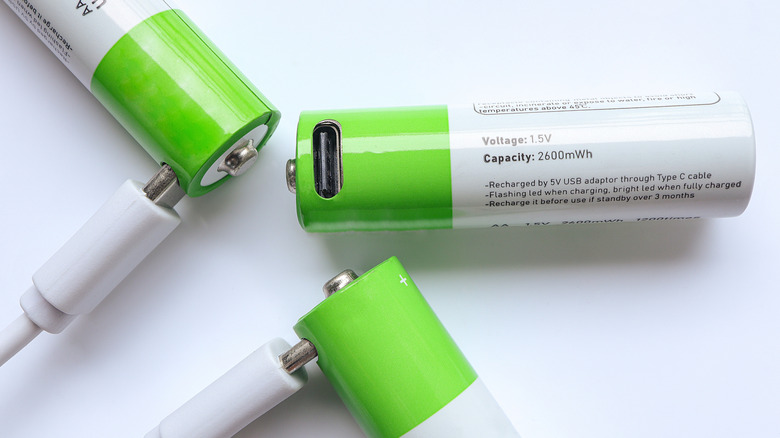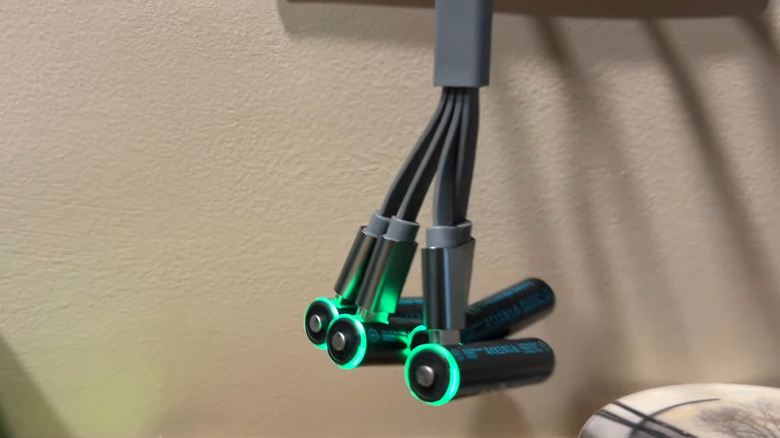The Biggest Pros And Cons Of Using USB-C Rechargeable Batteries
We may receive a commission on purchases made from links.
Most households have several devices that run on AA or AAA batteries. This includes everything from TV remotes and alarm clocks to flashlights and smart door locks. These devices can last for months on one set of batteries, but once the power runs out, your only option is to buy new ones. The problem is that disposable alkaline and zinc-carbon batteries aren't great for the environment and require proper disposal. Thankfully, there's a better alternative: rechargeable batteries that charge via USB-C.
A rechargeable USB-C battery looks much like a regular single-use battery, but with one key difference: it has a USB-C port built into the positive end. When it runs out of power, you simply need to recharge it using a charger and it's ready to go again. You can get these batteries in all common sizes, including AA, AAA, C, and D.
USB-C rechargeable batteries are quite convenient. They work just like regular batteries, but instead of being single-use, you can recharge them using a USB-C cable. But does it actually make sense to pay extra for USB-C rechargeable batteries? Here's a quick look at the main pros and cons to help you decide.
Pro: cost-effective and eco-friendly in long run
Although single-use batteries might seem cheap at first, the cost can add up fast, especially if you have a lot of devices that rely on them. Think of all the things that use these batteries: TV remotes, security cameras, your kid's toys, and more. A major benefit of USB-C rechargeable batteries is that you can use them over and over again before they wear out. This can save you both money and extra trips to the store.
Another advantage of rechargeable batteries is their ability to cut down e-waste. Instead of constantly buying new ones, you can reuse the same battery many times, which means far fewer end up in landfills. The environmental benefits go beyond just disposal. A single USB-C rechargeable battery can replace hundreds of disposable ones. That also means a reduced demand for raw materials, manufacturing, and packaging that go into producing new ones. Even from a production standpoint, rechargeable batteries tend to have a smaller environmental footprint than regular ones.
Pro: easy to recharge and lightweight
Rechargeable lithium-ion batteries have been around for a while, but most of them still need a dedicated charger. USB-C rechargeable batteries offer a much simpler solution. Instead of a special charger, you can use a standard phone charger, a USB wall outlet, or a power bank. You can even use the USB port on your TV, laptop, or car to charge them.
Since USB-C is so widely used, there are plenty of ways to keep these batteries powered. Many models also come with a multi-connector cable, so you can charge up to four batteries from a single source. Compared to traditional rechargeable batteries, USB-C versions are just a lot more convenient.
Since USB-C rechargeable batteries use lithium-ion technology, they're also lighter than single-use alkaline batteries. A typical AA alkaline battery weighs about 25 grams, while a USB-C rechargeable comes in at around 15 grams. The difference might not seem like much, but if you're powering something that takes multiple batteries, like a large flashlight or a toy, you'll end up shaving off a few extra grams with the rechargeable option.
Con: higher upfront cost
One of the main reasons people hesitate to buy a USB-C rechargeable battery is the price. Traditional single-use options are pretty affordable. For instance, a four-pack of Duracell AA batteries sells for about $5 on Amazon, which comes out to $1.25 per piece. And if you buy in bulk, the price drops even more. A 100-pack of Amazon Basics AA batteries goes for around $27, which breaks down to just 27 cents per battery.
For comparison, a pack of four AA USB rechargeable batteries from Pale Blue costs around $30 on Amazon, or about $7.50 each. This makes a single USB-C rechargeable battery roughly six times more expensive than a regular one. Although high-quality USB-C batteries can save money over time, the upfront cost is hard to ignore. This is particularly true if you need to buy several at once or plan to use them in low-drain devices like a TV remote, which doesn't need new batteries very often.
Con: longer charging time
Another major downside of USB-C rechargeable batteries is that they still need to be charged. How often you'll need to do that depends on the device and its power usage, so it can vary. On average, a full charge takes between 1.5 hours to 2 hours. Also, charging multiple batteries at once can be a hassle unless you've got a cable with multiple connectors. Even then, sharing one power source across several batteries usually slows things down.
And just like the battery in your smartphone or laptop, a USB-C battery loses its ability to hold a charge with regular use. Over time, you may notice it needs recharging more frequently. Since these batteries don't have a built-in indicator to show you when they're running low, it's easy to get caught off guard. You could run out of power right when you need it and end up waiting for it to recharge before you can use it again.




